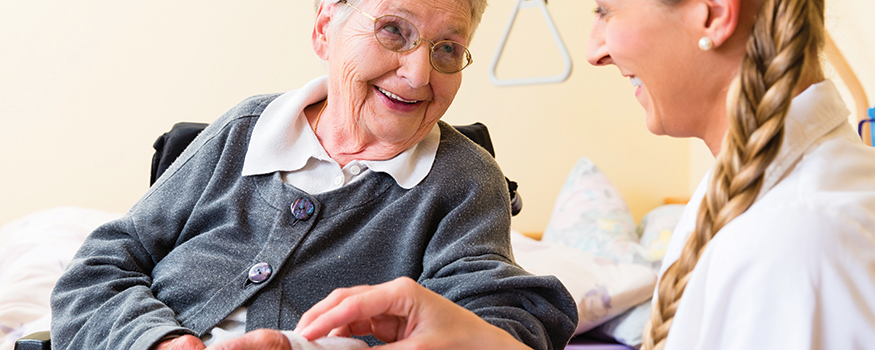Developing a pressure ulcer can cause the patient pain, lead to social isolation, result in reduced mobility, and can even be fatal. According to the Agency for Healthcare Research and Quality, estimated costs for each pressure ulcer range from $37,800 to $70,000, and the total annual cost of pressure ulcers in the United States is an estimated $11 billion.
Nurses understand their role in preventing pressure ulcers, but what role do patients play in the prevention plan? Nurses need to empower the patient to be an active member in health promotion activities and participate in prevention measures. In this article, I highlight the importance of incorporating pressure ulcer prevention into patient education for high-risk patients as a way to empower patients. Empowered patients can help improve outcomes and reduce overall costs of this hospital-acquired complication.
Patient engagement
A basic element of empowerment is engagement. Nurses must practice a patient-centered approach to healthcare delivery that embraces and supports the belief that patients are, or can become, competent to make informed decisions. Engaged patients tend to function better, experience fewer symptoms, and are less likely to experience an adverse event compared to those who aren’t engaged.
As a practicing nurse, you would think that engaging patients in their care would lie at the core of the culture of our healthcare system; unfortunately, that is not always the case. For example, sometimes we forget to explain to patients why we are asking them to perform health promotion activities. If we instruct patients to follow a direction without explaining the meaning behind it, they may be less likely to actively participate in the activities.
Helping patients understand the reason behind an activity, instead of making it seem like we are ordering them to do it, can help performance and adherence levels. With our expertise and close proximity to patients, we are able to take a leading role in engaging them in their care.
The value of teach-back
High-risk patients must be informed about pressure ulcers, including prevention and complications. Arming patients with knowledge makes them feel empowered to actively participate in their health promotion. Unfortunately, studies reported by Dewalt and colleagues note that 40% to 80% of information taught to patients is forgotten immediately. The teach-back method is one way to reduce those percentages.
In the teach-back method, patients teach the information taught to them back to the nurse. This can be done through discussion or demonstration, depending on the topic. (See More about teach-back.) When information is correctly taught back, it confirms that the patient understands the content. Using the teach-back method in combination with daily reinforcement from nursing staff can help to solidify the knowledge learned and encourage implementation of health practices.
Integrating into care
Latimer, Chaboyer, and Gillespie reported that after conducting interviews regarding pressure ulcer education, patients had varying knowledge of pressure injuries and only a few reported receiving education from healthcare providers about risk factors and strategies to prevent pressure ulcers.
To ensure pressure ulcer prevention education occurs when needed, it’s helpful for this education to be part of the standard of care for high-risk patients. Making these education sessions mandatory and using the teach-back method to confirm understanding can help patient adherence to suggested prevention interventions. As nurses, we are empowering our patients by effectively supplying them with information they need to make good choices and be active in promoting their health.
Clinicians should document that education was provided and its level of effectiveness. Evidence of effectiveness includes patient involvement in prevention measures, such as actively turning themselves. Proper documentation by nursing staff shows the effect of education on patients’ participation in their own health promotion activities. Although education may take time, the time spent outweighs the complications of this debilitating condition. After all, it is far easier to prevent a complication than it is to treat one and regain a patient’s health.
Promoting engagement
A pressure ulcer often results in patient pain and suffering, poor patient outcomes, decreased quality of life, and increased costs for both patients and their providers. The integration of pressure ulcer prevention into required patient education using the teach-back method empowers and engages patients, fostering their active participation in their own health promotion. Healthcare providers and patients can work together as a team to prevent the many costs of pressure
ulcers.
Hannah Miller is a clinical learning lab specialist at Chamberlain College of Nursing in Cleveland, Ohio.
Selected references
Agency for Healthcare Research and Quality. Pressure ulcer treatment strategies: Comparative effectiveness. Comp Eff Rev. 2013;90. effectivehealthcare.ahrq.gov/ehc/products/308/1492/Pressure-ulcer-treatment-executive-130508.pdf.
DeWalt DA, Callahan LF, Hawk VH, et al. Health literacy universal precautions toolkit. AHRQ. 2010.
Gillespie BM, Chaboyer W, Sykes M, et al. Development and pilot testing of a patient-participatory pressure ulcer prevention care bundle. J Nurs Care Qual. 2014;29(1):74-82.
Latimer S, Chaboyer W, Gillespie BM. Pressure injury prevention: do patients have a role? Qld Nurse. 2012;31(4):33.
Sherman RO, Hilton N. The patient engagement imperative. Am Nurse Today. 2014;9(2).
americannursetoday.com/the-patient-engagement-imperative.
Online Resources
A. http://www.teachbacktraining.org/







